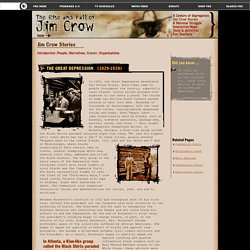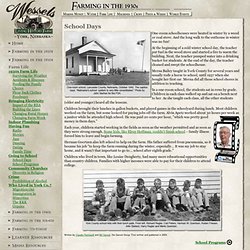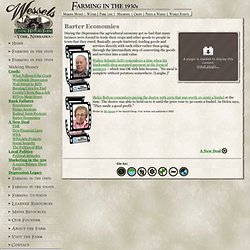

Race. Employment. Class in the 1930's. Despite the fact that nearly everyone in the country was hurt to some degree by onset of the Depression, the 1930's was a period of exacerbted class conflict.

One possible reason for this was the divergent responses which upper and lower class individuals had to the crisis. While many of the richest people in America lost money when the stock market crashed, the upper classes as a whole still retained much of the wealth which they had held before the Depression and in most cases did not suffer from unemployment. Perhaps as a way of displaying their continued prosperity in the face of nationwide suffering (or of trying to show up their social equals who may have been hit harder by the crash) many among the upper classes began to flaunt their wealth more than ever. The Rise and Fall of Jim Crow . Jim Crow Stories . The Great Depression. In 1929, the Great Depression devastated the United States.

Hard times came to people throughout the country, especially rural blacks. Cotton prices plunged from eighteen to six cents a pound. Two thirds of some two million black farmers earned nothing or went into debt. Hundreds of thousands of sharecroppers left the land for the cities, leaving behind abandoned fields and homes. Even "Negro jobs" -- jobs traditionally held by blacks, such as busboys, elevator operators, garbage men, porters, maids, and cooks -- were sought by desperate unemployed whites.
In Mississippi, where blacks traditionally held certain jobs on trains, several unemployed white men, seeking train jobs, ambushed and killed the black workers. Harper Lee. Southern Literary Trail - Monroeville, AL: Truman Capote & Harper Lee. To Kill a Mockingbird. Harper Lee (b. 1926) If Nelle Harper Lee ever wanted proof that fame has its drawbacks, she didn't have to look farther than her childhood neighbor, Truman Capote.

After her enormously successful first novel, she has lived a life as private as Capote's was public. Nelle-her first name is her grandmother's spelled backward-was born on April 28, 1926, in Monroeville, Alabama. Watch American Masters Online. Education. Cliff Peterson on Walking to School. Elroy Hoffman Working the Wessels Family. What School Days Were Like in Depression Rural America. School Days One-room schoolhouses were heated in winter by a wood or coal stove.

Going to School in Rural America during the 1930s. Going to School Country schools went through hard times in the 1930s.

The value of farm land plummeted, and that meant that property taxes that supported schools fell as well. During the Great Depression, some school districts couldn't pay their teachers. One-room grade schools were still common in York County, Nebraska, and other Great Plains states. Children from several grades sat in one room, often led by a teacher not much older than the students. The dust and heat or snow and cold sometimes made it hard for children to learn and for teachers to teach. Like many farm children, Herman Goertzen rode his horse to grade school. Bartering. The Rise of the Barter Economy. A handshake in the back yard lands the family a Model T. Valley Legend Mary Cook ‘s father bartered a load of gravel for their Model T Family’s first car was a diamond in the rough – News – By Mary Cook Kanata Community News.

Mother often wondered if we got a bargain when Father traded many loads of gravel for the old Model T, our first car. Bartering to Make it through the Depression. Barter Economies During the Depression the agricultural economy got so bad that many farmers were forced to trade their crops and other goods to people in town that they owed.

Basically, people bartered, trading goods and services directly with each. Great Depression Overview. Great Depression. The stock market crash in the waning days of October 1929 heralded the beginning of the worst economic depression in U.S. history.

The Great Depression hit the South, including Georgia, harder than some other regions of the country, and in fact only worsened an economic downturn that had begun in the state a decade earlier. U.S. president Franklin D. Roosevelt's programs for economic relief and recovery, known collectively as the New Deal, arrived late in Georgia and were only sporadically effective, yet they did lay the foundation for far-reaching changes. Not until the United States' entry into World War II (1941-45) did the depression in Georgia fully recede.
The Great Depression Video — History.com. Great Depression (1930's) News. A Short History of the Great Depression By Nick Taylor, the author of “American-Made” (2008), a history of the Works Progress Administration.

The Great Depression was a worldwide economic crisis that in the United States was marked by widespread unemployment, near halts in industrial production and construction, and an 89 percent decline in stock prices. It was preceded by the so-called New Era, a time of low unemployment when general prosperity masked vast disparities in income. The start of the Depression is usually pegged to the stock market crash of “Black Tuesday,” Oct. 29, 1929, when the Dow Jones Industrial Average fell almost 23 percent and the market lost between $8 billion and $9 billion in value. But it was just one in a series of losses during a time of extreme market volatility that exposed those who had bought stocks “on margin” — with borrowed money.